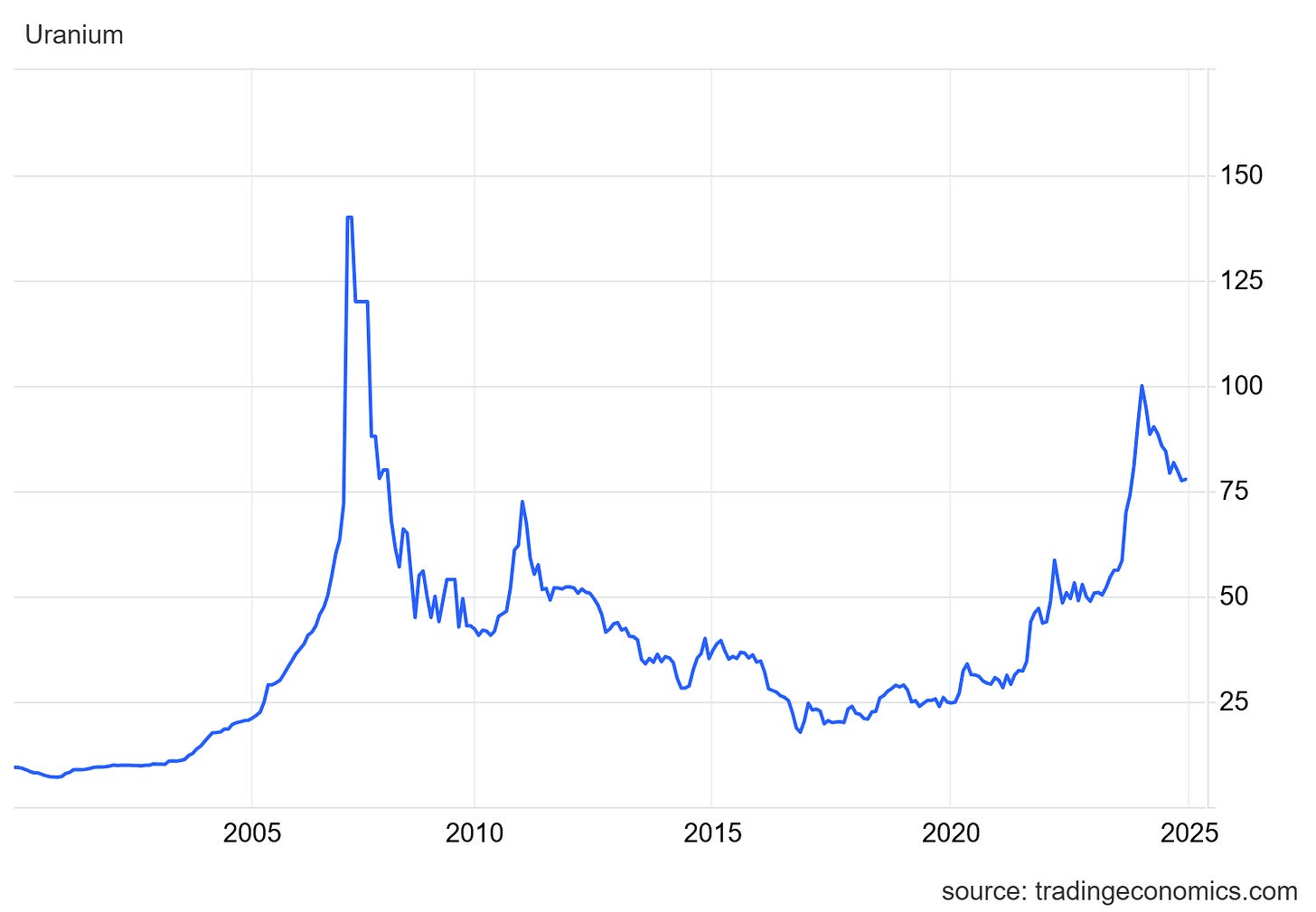🔋A Look At U
Could we be witnessing the resurrection of domestic uranium mining?
If you found this article interesting, click the like button for me! I would greatly appreciate it :)
In 2023, three new uranium mines came back into production near the Utah/Arizona border. A few more have come online this year and even more are in the works. How is this possible considering the stifling Nuclear Regulatory Commission (NRC)? The answer is that the mines aren’t new. These mines are fully permitted and have been for years or decades, many of which have supplied uranium in the past only to lay dormant in recent years.
The mining of uranium, or uranium oxide, is very connected to the price of the underlying material. Much like other types of mining, if the price of the sold material does not exceed the production costs, it is not worth digging up. From 2011 to 2020, uranium was in a vicious bear market. Only recently has the price eclipsed that of the January 2011 peak. With higher energy, labor, and regulatory costs in the US, it is only becoming favorable to mine domestically now.
For many years, the US led the world in nuclear technology and mining. In the 80s domestic production fell off in favor of imports. Since then, the domestic production of uranium to commercial reactors has been meager at best. More than 90% of the fuel for domestic reactors comes from imported materials. Increased protectionism creeping into policy and concerns about supply chains after COVID have the US more concerned than ever about the supply of raw materials. According to the Department of Energy (DOE), uranium is right up with lithium in terms of strategic importance.
US production of uranium for various reasons including profitability, regulations, globalization, and others has led the US to be a minority player in the mining of many things over the last few decades. Currently, the US is the 9th largest producer of uranium oxide with 1.8% of the global share of production. Kazakhstan, Canada, and Australia are the top three. From a raw material security standpoint, it is good that two of the top three producers are close allies with the US.
These figures do make it seem like a few mines opening in the US is a bit inconsequential in the grand scheme, but it is a natural consequence of higher uranium prices and increasing sentiment towards nuclear power. Last week I discussed the surprising support for nuclear energy at the COP29, a classic pro-renewable/anti-fossil fuel crowd. At this time, there are nearly 30 nations committed to triple nuclear capacity by 2030 including the US. While both political parties raise the strategic minerals as a priority, only one has a desire to bring production to the US.
We’re going to become a major producer of…minerals. We’re going to create jobs, making…us truly self-reliant. - Donald Trump
While it remains to be seen how effective these policies will be economically, President-elect Trump has been vocal about supporting the domestic production of most resources. His platform largely revolves around bringing back industry and manufacturing jobs to the US. In addition, the protectionist rhetoric is aligned with trying to be as self-reliant as possible, which includes mining. Price is the main arbiter of mining profitability, but it will be interesting to watch to see what, if any other incentives the Trump presidency gives to encourage domestic mining. These could include expedited permitting, tariffs, tax cuts, and subsidies.
Uranium oxide, the precursor to nuclear powerplant fuel is a key strategic resource for the US. Especially with the renewed emphasis on domestic supply chains and security, the mining of key raw materials has come into the spotlight. Uranium oxide production in the US is lacking and has been for decades, but dormant permitted mines have been coming online in the past two years.
This could be the beginning of a trend, especially given a Trump term focused on re-shoring lost industries and less focus on environmental and corporate regulations. To fully see the recovery of domestic mining, the permitting of new mines needs radical change Further, the price of uranium must remain at these elevated levels. While this has the ingredients to be the beginning of a trend, it remains to be seen what kind of economic impact this has on consumers and the geopolitical landscape. Until next week,
-Grayson
Leave a like and let me know what you think!
If you haven’t already, follow me at TwitterX @graysonhoteling and check out my latest post on notes.
Socials
Twitter/X - @graysonhoteling
LinkedIn - Grayson Hoteling
Archive - The Gray Area
Let someone know about The Gray Area and spread the word!
Thanks for reading The Gray Area! Subscribe for free to receive new posts and support my work.





